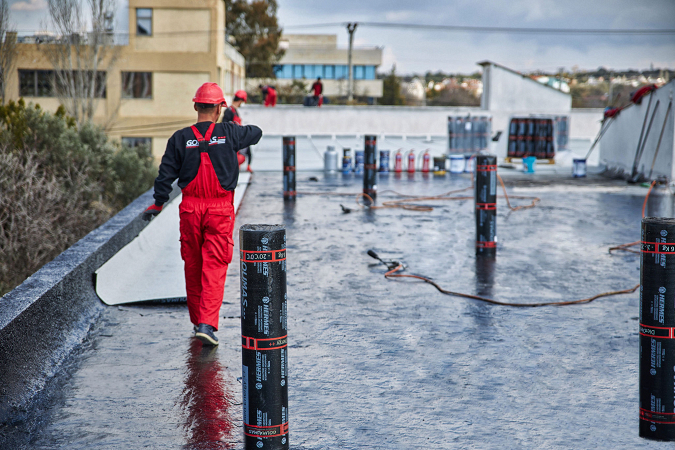In recent years, the market has been inundated with hundreds of spreadable materials which are manufactured by small and large companies and promise affordable and long-term waterproofing of rooftops and rooftop buildings. What is the truth?
To begin with, according to the standard EN 1504-2, most spreadable materials have been certified as concrete protecting products and must be applied to the building either in other application, e.g., waterproofing of walls, masonry and basements, tanks, pools, etc., or as auxiliary waterproofing materials, e.g., as a primer for proper bituminous sheet adhesion, as cold paint to shield the concrete from solar radiation, for the maintenance of old insulation. etc.
According to the European directive ETAG 005, only a number of spreadable materials are certified as sealant and only these are suitable for waterproofing rooftops and rooftop buildings (some of these include: Hyperdesmo, Sikalastic 612, Mariseal 250).
Nevertheless, even between these spreadable rooftop sealants, they vary greatly in quality, which is distinguished by the following:
- Their base
Depending on their base, they are divided into hybrid, silane, polyurethane.
Polyurethanes are considered the ideal choice.
- Their elasticity
Spreadable rooftop sealants must be highly flexible in order to able to absorb the contractions and expansions of the underlay. They should also be able to bridge small cracks and retain their properties in a large temperature range (-40 oC to + 80 oC).
- Their life expectancy
The life expectancy ranges from 10 to 25 years in ideal factory conditions, based on the manufacturer's application of the respective product.
- The climate
The manufacturer must state which climate in which the spreadable rooftop sealants are suitable (M= mild - S= severe).
- The reflection factor
The products should maintain their high whiteness and solar reflectance for a good number of years. Products, such as polyurethanes, which tend to take on a yellow tinge over time must be protected with a coat of aliphatic polyurethane varnish.
- Consumption
Generally speaking, spreadable rooftop sealants are not cheap. Depending on the brand there are small difference in the kilo price and large differences in the recommended consumption which may range from 1.5 kg per square metre to 3 kg.
- The additional materials that are required
Waterproofing with spreadable materials cannot only be done with one material. Depending on the material used, the underlay on which the insulation will be applied and the desired walkability may require: specialized primers for the best adhesion of the material to the underlay, reinforcement either total or only in vulnerable areas (depending on the specifications of the material), aliphatic varnish to protect the waterproofing from UV radiation, sprinkling of quartz sand, etc. All of the above should be taken into account in the final cost of the waterproofing system.
The problem does not only lie in the choice of suitable waterproofing materials, but also extends to their application.
Because these materials are spreadable, there is the notion that even an amateur can apply it (do it your self). This can result in waterproofing failures and "childish" mistakes and oversights that will be evident from the first year.
Some poor application examples include:
- Application on an unsuitable or unsound underlay, e.g., on lightweight concrete.
- Application on a moist underlay.
- Application on an underlay that has not been appropriately cleaned and prepared for the coating.
- Application with the wrong primer or no primer.
- Application with very small consumptions and the creation of thin waterproofing.
- Violation of mixing ratios.
- Violation of work time and wait until next layer.
- Application without reinforcing vulnerable areas, such as: Pipe sleeves, pipes that penetrate the concrete, railings, bases from solar panels and tanks, downspouts, etc.


